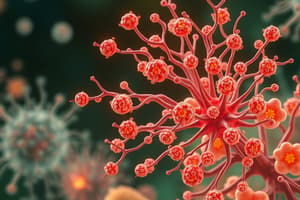Podcast
Questions and Answers
What is the primary mechanism of action of tetracycline?
What is the primary mechanism of action of tetracycline?
- Inhibits the synthesis of folic acid
- Binds to ribosomes and blocks protein synthesis (correct)
- Inhibits the reverse transcriptase enzyme
- Prevents penetration of viruses into host cells
Which statement accurately describes sulfonamides?
Which statement accurately describes sulfonamides?
- They are primarily used to treat parasitic infections
- They are effective against all viruses
- They prevent the maturation of viral particles
- They interfere with the synthesis of folic acid in bacteria (correct)
What role does reverse transcriptase play in retroviruses?
What role does reverse transcriptase play in retroviruses?
- Translates DNA into RNA
- Converts RNA into DNA (correct)
- Blocks viral entry into host cells
- Inhibits protein synthesis
How do multi-drug resistant (MDR) pumps contribute to drug resistance in bacteria?
How do multi-drug resistant (MDR) pumps contribute to drug resistance in bacteria?
What are biofilms, and what percentage of infections do they involve?
What are biofilms, and what percentage of infections do they involve?
Flashcards
Tetracycline
Tetracycline
An antibiotic that stops bacteria from making proteins by binding to their ribosomes.
Sulfonamides
Sulfonamides
Antibiotics that target essential bacterial processes and some fungal infections by preventing the synthesis of folic acid.
Ivermectin
Ivermectin
A drug that kills parasites, especially roundworms and lice.
Reverse Transcriptase
Reverse Transcriptase
Signup and view all the flashcards
Biofilms
Biofilms
Signup and view all the flashcards
Study Notes
Chapter 12 Notes
- Tetracycline binds to ribosomes, blocking protein synthesis
- Sulfonamides are antimicrobial drugs that interfere with bacterial metabolic processes, specifically folic acid synthesis
- Ivermectin is a broad-spectrum antiparasitic used to treat roundworm infections and lice
- Major modes of action include blocking viral penetration, replication, transcription, and translation, and preventing viral particle maturation
- Reverse transcriptase (RT) is a crucial target for HIV; it's the enzyme converting viral RNA to DNA
- Interferon is a glycoprotein produced by fibroblasts and leukocytes in response to immune stimuli
- Drug resistance is an adaptive response where microorganisms tolerate higher drug concentrations after initial exposure
- Many bacteria have multi-drug resistant (MDR) pumps to actively transport drugs out of the cell
- MDR pumps lack selectivity, transporting a wide range of drugs
- Biofilms, complex communities of microorganisms growing within an extracellular matrix, account for about 60% of infections
Studying That Suits You
Use AI to generate personalized quizzes and flashcards to suit your learning preferences.




